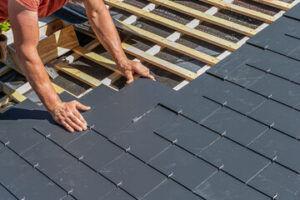There are many factors that contribute to the cost of roof replacement. The type of roofing material you choose is a big one.

Re-roofing adds a new layer of shingles over the existing ones. It’s less expensive than a full roof replacement, but it doesn’t fix structural damage. It also may not be appropriate if the old shingles were architectural or dimensional shingles. Contact Missoula Roofing for professional help.
Asphalt shingles are one of the most popular roof coverings in use today, and they offer a great balance of price and performance. This wallet-friendly material comes in a wide variety of colors and styles to complement any design aesthetic. Additionally, asphalt shingles are relatively easy to install, and most roofing professionals can complete the job fairly quickly.
When properly installed and maintained, asphalt shingles are highly durable and provide excellent weather resistance. However, this type of shingle can be vulnerable to moisture and algae growth. If left unchecked, these problems can lead to premature shingle failure. This can reduce the lifespan of your roof and detract from its aesthetic.
Fortunately, these problems are often avoidable with regular cleaning and maintenance. It’s also important to regularly inspect your roof, and replace any damaged shingles as needed. By following these simple tips, you can help your asphalt shingles last longer and stay looking like new.
Three-Tab Shingles
The oldest basic asphalt shingle type is known as the three-tab shingle, and it features cut-outs that create a repetitive pattern that gives your roof a distinct look. It’s the most affordable option, and it offers a good level of protection against the elements.
A 3-tab shingle starts with a base layer of fiberglass mat coated with asphalt and then covered in ceramic granules. These granules give your roof color and protect the asphalt from sunlight’s damaging UV rays. This basic shingle type is also resistant to wind uplift and provides effective water penetration protection.
An architectural or dimensional shingle is thicker than a traditional 3-tab shingle, and it’s designed to resemble a wood shake or slate. These shingles can offer superior energy efficiency and enhanced impact resistance.
These shingles can be more expensive than a standard three-tab shingle, but they are the most popular option for many homeowners. The thicker construction offers better durability and insulation, which can offset the higher initial cost.
Tiles
Tiles are thin modular sheets of materials like ceramic, stone, metal, glass, or concrete. They are installed on floors, walls and countertops to provide a decorative and durable covering that’s easy to clean and water-resistant. Tiles come in a variety of styles, colors and textures to complement any design aesthetic.
Tile is often used in bathroom and kitchen areas where the surface is prone to moisture. However, they are also found in outdoor areas and in other spaces where a durable, easy-to-clean surface is desired. Tiles can be made from a number of different materials, including glazed and unglazed pottery, concrete and other composite materials, stone, metal, and glass.
Some tiles are shaped in specific shapes that can be replicated to cover an area without gaps, called a tessellation. Examples of tessellation include the hexagonal tiles of Islamic polychrome decorative tilings and the more complex geometric patterns of Penrose tilings.
When installing tile, the surface that will be covered should be cleaned and prepared before applying the adhesive. Then, using a level and measuring tape, mark out a grid pattern that will guide the placement of the tiles. The grid pattern will help ensure that the tiles are even and properly spaced. After the adhesive has been applied to a small section of the floor, lay the tiles in the pattern specified by the grid pattern, spacing them evenly and placing spacers as needed.
Thatch
Thatch is a tightly intermingled layer of dead and living shoots, stems and roots that develops between the top of an actively growing turf and the soil. It is a natural part of any well-managed lawn, providing that it does not become too thick.
When thatch builds up, it can cause a wide variety of lawn problems. Excessive thatch prevents water, air and nutrients from reaching the grass roots and starves the lawn of essential elements. Thatch also creates a favorable environment for insects, diseases and weeds to thrive in.
Thatching can be done with a variety of materials, depending on the climate and landscape. For example, straw thatch is common in tropical regions. Thatching with palm leaves (Cocos nucifera) is a practice in the southeastern United States, particularly in Native and pioneer houses that were built with these types of leaves.
A roof made with thatch provides good insulation. Air pockets in the thatch absorb the sun’s heat, and they also keep a house warm in winter. The thatching process is labor-intensive, but it is also relatively inexpensive.
Thatch can be a fire hazard, especially in drought conditions. Dry thatch can easily ignite when sparks from paper or trash fall on it or when flames from a chimney ignite the dry thatch surrounding it. This type of fire is often called a thatch fire.
A thatch buildup can be caused by several factors, including poor soil aeration, improper lawn watering practices, and cold soil temperatures. Acid soils may also inhibit the growth of thatch-decomposing microorganisms.